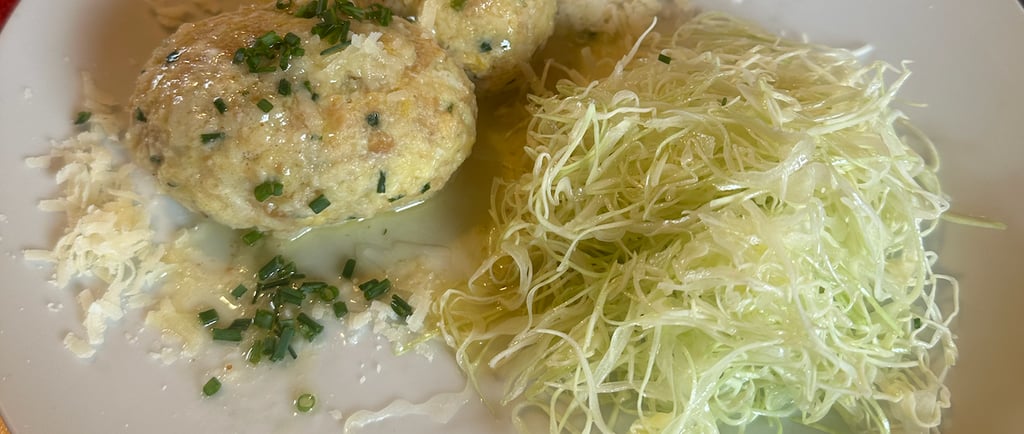Canederli: Tyrolean dumplings, friendship, and "the art of flirting" in the mountains
Canederli are a celebration of resourcefulness, tradition, and friendship. Every bite reminds me of mountain air, laughter around the table, and my friend Andrea’s patient lessons on Tyrolean culture (and "ladin" pronunciation). And maybe, just maybe, a little bit of mountain flirting... Because sharing Canederli with someone special is its own kind of alpine romance.
FRIENDS FAVORITESITALIAN ROOTS
7/9/20252 min read


There are dishes that taste like home, and others that taste like friendship. For me, Canederli (those hearty Tyrolean bread dumplings) are a bit of both. Every summer in the Dolomites, I find myself trying them, and this year’s plate was extra special: not only did I get to enjoy Canederli in their alpine birthplace, but I also learned the secrets behind them from my friend Andrea, a true Alto Adige local, 17 years old, charming, funny, and now officially my Canederli guru.
The Story Behind Canederli
Andrea insists on the correct pronunciation: kah-NEH-der-lee. He told me that Canederli are a symbol of mountain ingenuity and warmth.
Born from the need to use up stale bread and leftovers, Canederli have been a staple in South Tyrolean kitchens for centuries. In fact, the first known depiction of Canederli dates all the way back to a 12th-century fresco in the chapel of Castel d’Appiano near Bolzano.
Legend has it that these dumplings were invented by resourceful women who, faced with hungry mercenaries and few ingredients, mixed bread, eggs, speck, and milk into hearty balls that could satisfy even the fiercest appetite. Today, they’re a beloved comfort food (especially for Andrea, who claims no trip to the mountains is complete without them!)
The Secret According to Andrea
What’s the secret to perfect Canederli? According to Andrea, it’s all about balance: the bread should be just moist enough to hold together, but never soggy; the speck (or pancetta) must be diced fine and sautéed with onions for extra flavor; and, most importantly, you must mix the dough gently - “like you’re making snowballs,” he says, “not bricks!” And one more tip: Canederli should always be cut with a fork, never a knife, to preserve their tender texture!
Traditional Canederli Recipe
Here’s the classic recipe I learned in the Dolomites:
Ingredients
250g stale bread, cubed
150g speck (or pancetta), diced
50g onion, finely chopped
2 eggs
250ml whole milk
10g butter
Parsley and chives, chopped
Black pepper and salt
Flour, as needed
Grated cheese (Trentingrana or Parmesan)
Method
Sauté the onion and speck in butter until golden.
In a large bowl, soak the bread cubes in milk. Add eggs, herbs, and the sautéed onion and speck. Mix gently.
If the mixture is too dry, add a splash more milk; if too wet, sprinkle in a bit of flour.
With damp hands, shape the mix into balls about the size of a golf ball.
Simmer the Canederli in gently boiling broth for 15 minutes, or until they float.
Serve hot, in broth or with melted butter and grated cheese.
Why I Love Them
Canederli are a celebration of resourcefulness, tradition, and friendship. Every bite reminds me of mountain air, laughter around the table, and Andrea’s patient lessons on Tyrolean culture (and, yes, pronunciation of his mother language: ladin). And maybe, just maybe, a little bit of mountain "flirting"... Because sharing Canederli with someone special is its own kind of "alpine romance".
Final Thoughts
Whether you’re a mountain lover, a bread-saver, or just someone in search of a new comfort food, Canederli are a delicious way to bring a taste of the Alps into your kitchen. And remember: the best recipes are the ones that come with a story!
Have you tried Canederli or have your own mountain food memories? Share them in the comments... I’d love to hear your stories!
Cooking Postcards
Explore global recipes and cultural food stories.
Contacts
CONNECT
info@cookingpostcards.com
© 2025. All rights reserved.
SOCIALS
